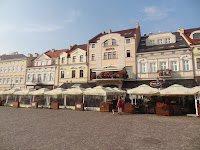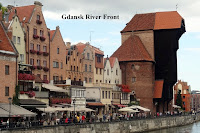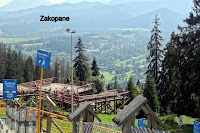The Plan
Poland is the birthplace of my Dad, Thomas Sr., and paternal
and maternal grandparents. It is a country that I knew little about except from
what I had learned from my parents and a short visit taken in the year 2000. It
is the country that my parents discussed with pride after expressing their love
of the USA.
In the early months of 2018, I decided that I wanted to tour
Poland and see a major portion of the country. My earlier trip taken with two
of my children, Mary and PJ, only included Warsaw, Krakow and Czestochowa. Now,
I wanted to see the entire country from its capital, Warsaw, to the Baltic
seaport, Gdansk, its mountainous resort, Zakopane, and the numerous cities and
villages that surround its outer boundaries.
Using the Internet to explore my options, I looked at
numerous tour organizations, their itineraries, tour group size,
accommodations, what was/wasn’t included and the cost. After a month of looking
here and there, I settled on a tour group, www.staypoland.com,
that dealt strictly with Poland tours which varied in duration. I chose the
longest tour , 16 days, which met my objectives – see a large portion of Poland
that included the major
cities/towns/villages, had a tour group not exceeding 20 individuals, four/five
star accommodations which were located centrally within a city/town, and a
reasonable cost that included all breakfasts
and fifty percent of lunches/dinners. I could not have made a better
choice….the tour was exactly as described and most importantly, our lead tour
guide and local tour guides were exceptional….I have traveled to over 90
countries and would rate this tour as one of the best that I have taken; A++.
The StayPoland Tour
Those of us born in the mid-twentieth century are familiar with Poland’s tragic
history – Nazi followed by Soviet occupation – a period of time that spanned
fifty years. Warsaw: Poland’s Capital which was destroyed during World War II; Gdansk: seaport city where Solidarity was born - the
beginning of the end of Soviet occupation; Krakow
– Auschwitz-Birkenau, Schlindler’s List – tragic history of Jewish atrocities; Czestochowa
– home to Poland’s Black Madonna Icon…..all of these cities are associated with Poland.
StayPoland’s
tour engages all of the above in addition a visit to Hitler’s Wolf’s Lair – the
Fuhrer redoubt during WW II; Malbork
Castle: home to the thirteen century
Teutonic Knights; Torun: birthplace of
astronomer Nicolas Copernicus and gingerbread cookies; Gniezno: ninth century
birthplace of Poland; Wroclaw:
capital of Poland’s Silesian region and home to 130,000 university students and
Zakopane: a lovely ski village located in Poland’s Carpathian Mountains.
Interspersed within the tour’s itinerary was a visit to a lavender farm accompanied by a delicious lunch; a punt (small flat bottom boat) trip through a forested stream; a raft trip down the Dunajec River which separates Poland and Slovakia and numerous visits to ABC (Another Beautiful Cathedral)/organ concerts.
The route traveled is indicated in the following map.

Except for our Torun stay, visits to every other location
involved a two or three night stay fostering a more leisurely pace to explore
one’s surroundings. Our lead tour guide, Katherine (Kasia) Cznykowska, lives
with her husband in Gdansk. Kasia was exceptional in her knowledge of Poland’s
history, her ability to communicate with her audience and her main asset; “I make the tour fit the needs of the people
and not make the people conform to the tour’s itinerary”. We saw Poland as
leisurely travelers not as tourist marching from one site to another. At each
major city/town, our tour had the services of a guide who was versed in local
history, points of interest and customs. Our accommodations were first class
and were located centrally so that we were able to easily “explore” our surroundings on our own. Each morning we
were served a breakfast that offered us a host of options from American
eggs/bacon/sausage to European selection of meat/cheeses; of course, a wide
selection of breads/rolls. Most lunches
were at our own expense while approximately one-half the dinners were included
in the tour. One additional positive was the tour transportation; a 30
passenger bus for our twenty member tour group which provided us adequate space
to relax. Rather than changing drivers, we had the services of the same bus
driver, Paul, throughout the entire tour.
Lessons Learned
One of the most enjoyable benefits of traveling is to
meet/talk to the people, learn about their lives, culture and country’s history.
I came to understand Poland in a different light after listening to individuals
who experienced the horrors of Nazi oppression and fought in the Polish underground.
I talked which led Eastern Europe in expelling Russia and their oppressive
minions back to their homeland. I visited numerous exceptional museums that
explored these achievements and spent on average three to four hours at each
museum walking through history and learning:
Did you know that Poland
1.
…was found in the 10th century in the
small town of Gniezno located in the
center of the country.
2.
…expanded and contracted in size and influence
over the centuries. Its magnate leaders selected outside European monarchs as
their leader for fear that a Polish leader would become too strong and diminish
their influence.
3.
…welcomed various minority ethnic groups into
Polish society; not as equals and with some prejudice. These groups which
included Gypsies, Jews, Mennonites, and others, were allowed to live within
their own communities, participate in business/community affairs and maintain/
practice their traditions.
4.
…was the second country after America to develop
a Constitution, May 1791, as a governing document. It introduced equality among
townspeople, nobility and peasants and eliminated control of Poland’s
parliament, Sejm, from the veto of powerful magnates.
5.
…was dissolved as a country in 1792 by Austria,
Prussia and Russia because of their opposition to Poland’s constitution which
they felt threatened the control of their own people….Russia received the
largest portion(eastern/central), Prussia the second largest (west/northern)
and Austria the smallest
(southern)….Poland ceased to exist.
6.
…after 123 years of occupation (ended in 1918 with Treaty ofr Versailles), Poland emerged as a country with its culture in tact. It was recreated after World War I with lands
taken from the Austrian/German Empire with its borders ill defined and
challenged by its neighbors.
7.
…was attacked in 1919 by Communist Russia with
the intent of incorporating Poland into the USSR and using its conquest as an
entrance to spread Communism into Western Europe. The Soviet army was defeated
at the Battle of Warsaw which resulted in a joint peace agreement in 1920.
8.
…was attacked by both Germany and Russia in
September 1939. The country’s government and military never surrendered; the
government operated in exile in England while the military formed the Polish
Underground.
9.
…3,500,000 Jews lived in Poland prior to the
beginning of World War II…..over 3,000,000 were murdered during the War by the
Nazis…..today, Poland’s Jewish population is under 10,000.
10.
…was given to Russia at the Yalta Conference as
a reward for their participation in defeating Nazi Germany. Poland became a
satellite of the Communist Russia for a period of 45 years.
11.
…was the major influence in expelling Communism
from Eastern Europe due to the efforts of Poland’s Solidarity movement, moral
support of Pope John Paul II and political support of the USA and Britain
(President Ronald Reagan and Prime Minister Margaret Thatcher).
12.
…established its eastern border in 1990 by
forcing Germany to finalize the German/Poland boundaries as a condition for
allowing Soviet based troops to exit Germany after the fall of Eastern Germany.
“Men
make history and not the other way around. In periods where there is no
leadership, society stands still. Progress occurs when courageous, skillful
leaders seize the opportunity to change things for the better”…. Harry S Truman





















































